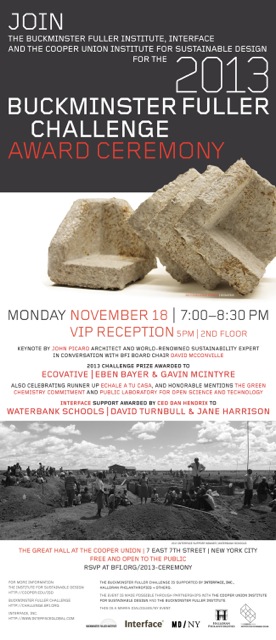 Join BFI on Nov. 18th at Cooper Union To Celebrate!
RSVP for the 2013 Buckminster Fuller Challenge Award Ceremony Below | The Buckminster Fuller Institute
Join BFI on Nov. 18th at Cooper Union To Celebrate!
RSVP for the 2013 Buckminster Fuller Challenge Award Ceremony Below | The Buckminster Fuller Institute
Welcome | The Buckminster Fuller Challenge
The Buckminster Fuller Institute (BFI) will award and celebrate the winning entry to the 2013Buckminster Fuller Challenge in an evening ceremony November 18th, 2013 at 7:00 pm hosted by the Cooper Union Institute for Sustainable Design.
The ceremony will include a Keynote talk by architect and world-renowned sustainability expert John Picard in conversation with BFI Board Chair David McConville. The $100,000 prize will be awarded to this year's winner, Ecovative, and new in 2013, Dan Hendrix, CEO of the Buckminster Fuller Challenge's first corporate sponsor, Interface Inc., will award additional support to Waterbank Schools! Join BFI, CUISD and Interface for this exciting opportunity to hear about leading edge design solutions from around the globe and to celebrate their incredible work. Please RSVP at bfi.org/2013-ceremony.
Each year a distinguished jury awards a $100,000 prize to support the development and implementation of a strategy that has significant potential to solve humanity’s most pressing problems.
Inspired by Buckminster Fuller
Buckminster Fuller's prolific life of exploration, discovery, invention and teaching was driven by his intention “to make the world work for 100% of humanity, in the shortest possible time, through spontaneous cooperation without ecological offense or disadvantage of anyone.”
Fuller coupled this intention with a pioneering approach aimed at solving complex problems. This approach, which he called “comprehensive anticipatory design science”, combined an emphasis on individual initiative and integrity with whole systems thinking, scientific rigor and faithful reliance on nature's underlying principles. The designs he is best known for (the geodesic dome, the Dymaxion house, car, and map, and the global electric grid) were part of a visionary strategy to redesign the inter-related systems of shelter, transportation and energy.
After decades of tracking world resources, innovations in science and technology, and human needs, Fuller asserted that options exist to successfully surmount the crises of unprecedented scope and complexity facing all humanity – he issued an urgent call for a design science revolution to make the world work for all.
Answering this call is what the Buckminster Fuller Challenge is all about.








